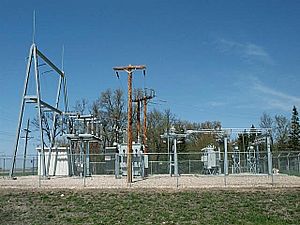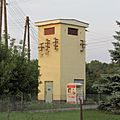Electrical substation facts for kids
An electrical substation is a special place in the electricity system. It's like a hub where the power changes its "strength" or voltage. This happens using big machines called transformers. Electricity often travels through several substations as it moves from where it's made (like a power plant) to your home or school. Each time, its voltage might be changed up or down.
Contents
What is an Electrical Substation?
An electrical substation is a key part of how electricity gets to us. Think of it as a special station where the "pressure" of electricity, called voltage, is changed. This change is super important because electricity needs different pressures for different jobs.
Why Change Voltage?
Electricity is made at very high voltages, sometimes hundreds of thousands of volts. This super high voltage is great for traveling long distances across the country. It helps reduce how much energy is lost as heat along the power lines.
But you can't use such high voltage in your home! It would be very dangerous and would damage your appliances. So, substations step down, or lower, the voltage to safer levels that homes and businesses can use. Sometimes, they also step up the voltage to send it further.
How Electricity Travels
Electricity starts its journey at a power plant. From there, it travels through a network of wires and equipment. Substations act like important checkpoints along this path.
From Power Plant to Your Home
1. Generation: Electricity is made at a power plant, usually at a medium voltage. 2. Step-Up Substation: Near the power plant, a substation steps up the voltage to a very high level (like 100,000 to 765,000 volts). This makes it efficient for long-distance travel. 3. Transmission: The super high-voltage electricity travels across long power lines, often seen as huge towers. 4. Step-Down Substation (Transmission): When the electricity gets closer to cities or towns, another substation steps down the voltage to a lower, but still high, level (like 13,000 to 230,000 volts). 5. Distribution Substation: Finally, smaller substations in neighborhoods step down the voltage even more (like 2,400 to 33,000 volts). This is the voltage that goes to local power lines. 6. Local Transformer: A small transformer, often on a pole or in a green box, steps down the voltage one last time to the safe level used in your home (like 120 or 240 volts).
Inside a Substation
Substations are filled with important equipment that helps manage the flow of electricity.
Transformers: The Voltage Changers
The most important pieces of equipment in a substation are the transformers. These are large, often noisy, metal boxes that change the voltage of electricity. They have no moving parts and work by using magnetic fields.
Circuit Breakers and Switches: Safety First
Substations also have circuit breakers and switches.
- Switches are like giant light switches. They can connect or disconnect parts of the electrical grid. This allows workers to safely do maintenance or reroute power.
- Circuit breakers are safety devices. If there's a problem, like a short circuit or too much electricity flowing, the circuit breaker automatically opens. This stops the power flow and protects the equipment and the rest of the electrical system from damage.
Control Room: The Brains of the Operation
Many larger substations have a control building. Inside, engineers and technicians monitor the substation's operations using computers. They can see how much power is flowing, check for problems, and control the equipment remotely. This helps keep the electricity supply stable and reliable.
Types of Substations
Substations come in different sizes and types, depending on their job in the electrical grid.
Transmission Substations
These are the largest substations. They connect the high-voltage transmission lines that carry electricity over very long distances. They might step up voltage from power plants or step it down for distribution to large areas.
Distribution Substations
These are smaller substations found closer to homes and businesses. They take the high voltage from transmission lines and step it down to a lower voltage that can be used by local power lines. From here, electricity goes to individual neighborhoods.
Why Substations are Important
Substations are vital for delivering electricity safely and efficiently. Without them, we wouldn't be able to use the power generated at distant power plants in our homes. They ensure that the right amount of electricity, at the right voltage, reaches everyone who needs it.
Staying Safe Around Substations
Substations contain very high voltages and powerful equipment. Because of the danger, they are always fenced off with warning signs. It's extremely important to never enter a substation or touch any of the equipment inside. Always stay outside the fences and respect the warning signs.
Related pages
Images for kids
-
A 50 Hz electrical substation in Melbourne, Australia. This is showing three of the five 220 kV/66 kV transformers, as well as high-voltage transformer fire barriers, each with a capacity of 150 MVA. This substation is constructed using steel lattice structures to support strain bus wires and apparatus.
-
High-voltage substation in Kaanaa, Pori, Finland
-
A distribution substation in Scarborough, Ontario disguised as a house, complete with a driveway, front walk and a mown lawn and shrubs in the front yard. A warning notice can be clearly seen on the "front door". Disguises for substations are common in many cities.
-
The Adélard-Godbout substation in Old Montreal is Canada's oldest substation, in continuous operation since 1901. It has a facade in clay brick with grey stone ornaments, to blend into its downtown environment.
-
Switchyard at Grand Coulee Dam, United States, 2006. This is a 500 kV switchyard.
See also
 In Spanish: Subestación eléctrica para niños
In Spanish: Subestación eléctrica para niños














